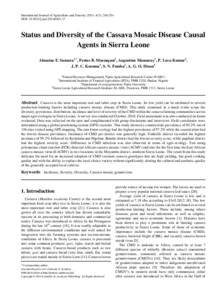| dc.contributor.author | Samura, A.E. |
| dc.contributor.author | Massaquoi, F.B. |
| dc.contributor.author | Mansaray, A. |
| dc.contributor.author | Kumar, P.L. |
| dc.contributor.author | Koroma, J.P.C. |
| dc.contributor.author | Fomba, S.N. |
| dc.contributor.author | Dixon, A. |
| dc.date.accessioned | 2019-12-04T11:03:27Z |
| dc.date.available | 2019-12-04T11:03:27Z |
| dc.date.issued | 2014 |
| dc.identifier.citation | Samura, A.E., Massaquoi, F.B., Mansaray, A., Kumar, P.L., Koroma, J.P.C., Fomba, S.N., & Dixon, A. (2014). Status and diversity of the cassava mosaic disease causal agents in Sierra Leone. International Journal of Agriculture and Forestry, 4(3), 246-254. |
| dc.identifier.issn | 2165-882X |
| dc.identifier.uri | https://hdl.handle.net/20.500.12478/1075 |
| dc.description.abstract | Cassava is the most important root and tuber crop in Sierra Leone. Its low yield can be attributed to several production-limiting factors including cassava mosaic disease (CMD). This study examined in a much wider scope the diversity, prevalence, distribution, incidence and level of severity of the CMD within the cassava farming communities across major agro ecologies in Sierra Leone. A survey was conducted October, 2010. Field assessment was also conducted on farms evaluated. Data was collected on the spot and complimented with group discussions and interviews. Field coordinates were determined using a global positioning system (GPS) recorder. This study showed a countrywide prevalence of 85.2% out of 156 sites visited using GPS mapping. The rain forest ecology had the highest prevalence of 97.2% while the coastal plain had the lowest disease prevalence. Incidence of CMD per district was generally high. Tonkolili district recorded the highest incidence of 99.2% followed by Kailahum and Pujehun. Bonthe district had the lowest severity score, while pujehun district had the highest severity score. Difference in CMD infection was also observed in terms of agro-ecology. Test using polymerase chain reaction (PCR) detected African cassava mosaic virus (ACMV) and also for the first time the East African cassava mosaic virus (EACMV) in two locations in the Moyamba district, southern Sierra Leone. The result from this study indicates the need for an increased adoption of CMD resistant cassava genotypes that are high yielding, has good cooking quality and with the ability to replace the local choice variety without significantly altering the cultural and aesthetic quality of the generally accepted local cultivar. |
| dc.language.iso | en |
| dc.subject | Cassava |
| dc.subject | Geminivirus |
| dc.subject | Mosaic Viruses |
| dc.title | Status and diversity of the cassava Mosaic disease causal agents in Sierra Leone |
| dc.type | Journal Article |
| dc.description.version | Peer Review |
| cg.contributor.affiliation | Njala Agricultural Research Centre |
| cg.contributor.affiliation | International Institute of Tropical Agriculture |
| cg.contributor.affiliation | Njala University |
| cg.contributor.affiliation | Sierra Leone Agricultural Research Institute |
| cg.coverage.region | Africa |
| cg.coverage.region | West Africa |
| cg.coverage.country | Sierra Leone |
| cg.authorship.types | CGIAR and developing country institute |
| cg.iitasubject | Cassava |
| cg.journal | International Journal of Agriculture and Forestry |
| cg.howpublished | Formally Published |
| cg.accessibilitystatus | Open Access |
| local.dspaceid | 78073 |
| cg.identifier.doi | https://dx.doi.org/10.5923/j.ijaf.20140403.17 |

